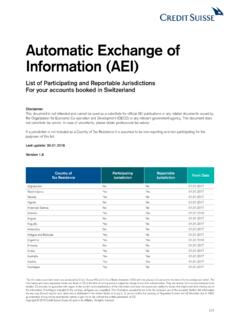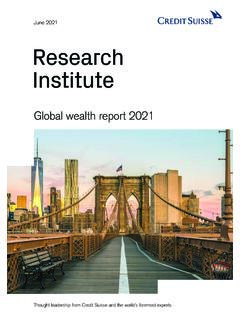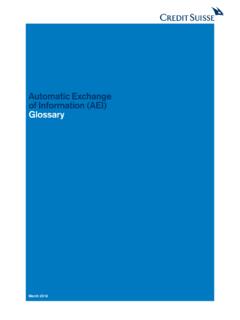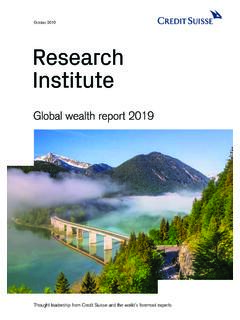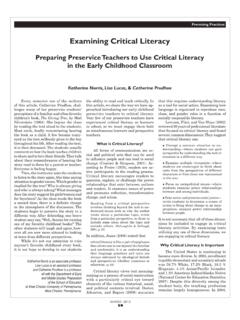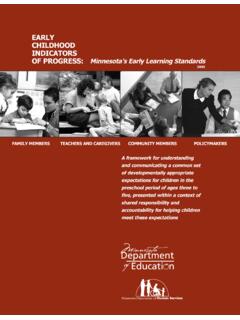Transcription of March 2021 Research Ins titute - Credit Suisse
1 Research Institute Elroy Dimson, Paul Marsh, Mike Staunton Thought leadership from Credit Suisse and the world s foremost expertsMarch 2021 yearbook 2021 Summary EditionCredit Suisse Global Investment Returns2 Summary EditionExtract from the Credit Suisse Global Investment Returns yearbook 2021 Important informationThis report is a summary version of the full 244-page Credit Suisse Global Investment Returns yearbook 2021, which is available in hardcopy upon request. Coverage of Summary EditionThis report contains extracts from the full hard-copy Credit Suisse Global Investment Returns yearbook .
2 In the yearbook , renowned financial historians Professor Elroy Dimson, Professor Paul Marsh and Dr. Mike Staunton assess the returns and risks from investing in equities, bonds, cash, currencies and factors in 23 countries and in five different composite indexes since 1900. This year, the database is broadened to include 90 developed markets and emerging markets, and the yearbook presents an in-depth analysis of nine new Summary Edition provides excerpts from the printed yearbook and spotlights Chapter 8 of the book. The summary starts with a historical perspective on the evolution of equity and sover-eign debt markets over the last 121 years, and the industrial transformation that accompanied this.
3 The next section explains why a long-term perspective is important and summarizes the long-run returns on stocks, bonds, bills and inflation since 1900. This is followed by a discussion on currencies and their impact on investment returns. The section on investment risk looks at dispersion in stock and bond markets on both the upside and downside culminating with global evidence on the historical risk premium. The Summary Edition then moves to prospective returns, showing how returns vary with real interest rates, looking at how expected returns vary over time and across markets, reflecting interest and inflation rates.
4 In a discussion of factor investing, there is an overview of the historical rewards from size, value, income, momentum, volatility and other factors. Chapter 8 of the printed yearbook examines emerging markets in detail and this chapter is reproduced in this Summary Edition. Topics include the nature, importance, evolution and profitability of emerging market investing, and studies of factor investing and rotation strategies within the developing world. The hardcopy publication provides an in-depth historical analysis of the investment performance of the 32 yearbook countries and five composite indexes, providing data sources and references.
5 This Summary Edition includes an overview of the investment performance of some of the world s most important markets since 1900, including Australia, China, Switzerland, the United Kingdom and the United States. It also includes analysis of three of the yearbook s composite indexes (developed markets, emerging markets and the World) and a list of references. Details on how to access the full Credit Suisse Global Investment Returns yearbook or the underlying DMS dataset are provided on page Suisse Global Investment Returns yearbook Summary Edition 2021302 Important information04 Message from the Chairman 05 Introduction and historical perspective12 Long-run asset returns18 Currencies21 Investment risk26 The low-return world29 Factor premiums32 Emerging markets52 Individual markets 53 Australia 54 China 55 Switzerland 56 United Kingdom 57 United States 58 Developed markets 59 Emerging markets 60 World61
6 References69 Authors70 Imprint71 General disclaimer / important informationExtracted from: Credit Suisse Global Investment Returns yearbook 2021:Elroy Dimson, Paul Marsh, Mike Stauntonemails: and for full yearbook 978-3-033-08425-4 For more information, contact:Richard Kersley, Head of Global Research Product, Credit Suisse Securities Research orNannette Hechler-Fayd herbe CIO International Wealth Management and Global Head of Economics & Research , Credit page 70 for copyright and acknowledgement instructions, guidance on how to gain access to the underlying data, and for more extensive contact photo: Kuala Lumpur, Malaysia; Getty Images, Piero Damiani; photo right: Kuala Lumpur, Malaysia.
7 Getty Images, Alexander Spatari4 Message from the ChairmanWe are delighted to publish the 13th edition of the Credit Suisse Global Investment Returns yearbook produced in collaboration with Professor Elroy Dimson of Cambridge University, and Professor Paul Marsh and Dr. Mike Staunton of London Business School. The long-term perspective this unique annual study provides has rarely seemed more valuable after a truly remarkable year in financial markets, with the COVID-19 pandemic and the economic and scientific responses to it the defining have seen equities plumb the depths of a severe bear market, with US equities falling by more than a third at their lows last March , but to then recover almost as swiftly as they fell and set new all-time highs all within the same calendar year.
8 While no perfect parallel for prevailing events exists, the yearbook , bringing a historical perspec-tive that stretches across 32 countries and up to 121 years, provides extensive examples to learn from as to the impact on markets from crises and economic policy, and technology responses to them. As is often said, history may not repeat itself, but it rhymes. This is the essence of the legacy of this crisis is record-low real interest rates and now-burgeoning fiscal deficits as governments have sought to soften the blow of the pandemic. Pulling this combination of policy levers has of course been to the benefit of financial assets.
9 However, the policy dilemma of if, and how, to unwind these crisis measures looms large, particularly with inflation expecta -tions hardening. The yearbook underlines the constraints for returns that a base line of low real rates poses if rates have indeed bottomed. The historical precedent would be for more modest real equity returns in their wake, but perhaps even greater challenges for bonds after their equity-like way of new thematic content, the 2021 edition of the yearbook brings to the table a highly topical deep-dive into emerging markets, reflecting the ever greater importance to global markets they reflect.
10 Only 20 years ago, emerg-ing markets made up less than 3% of world equity market capitalization and 24% of gross domestic product. Today, they comprise 14% of the free-float investable universe and 43% of gross domestic product, with their influence only likely to grow help investors frame assumptions for future returns and valuation, the study presents a substantial extension of the Dimson, Marsh and Staunton dataset. Nine new emerging markets have been added providing for each at least 50 years of performance of equities, bonds, bills, currencies and inflation. The markets include seven from Asia India, Hong Kong SAR, South Korea, Singapore, Taiwan (Chinese Taipei), Malaysia, and Thailand and two from Latin America Brazil and Mexico.

